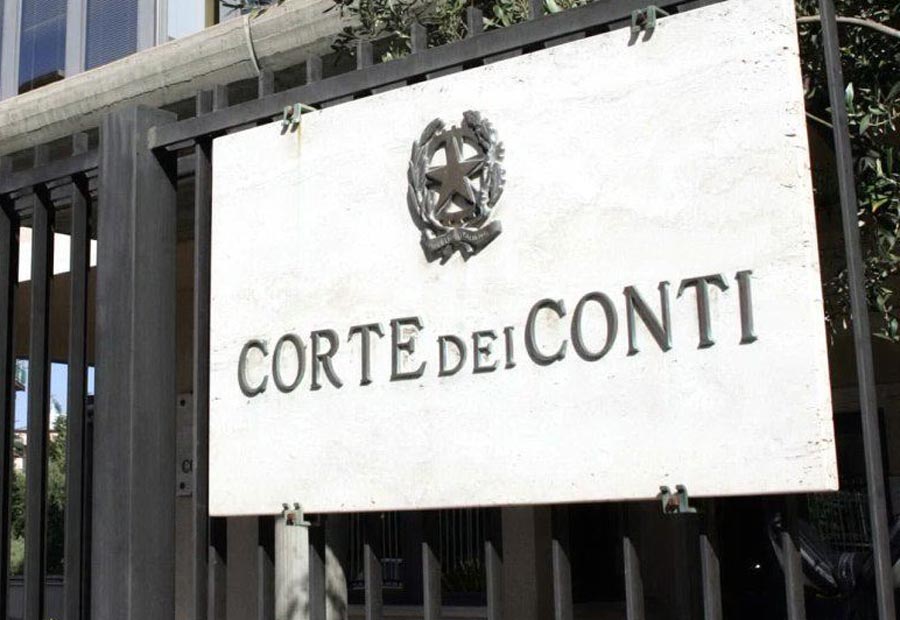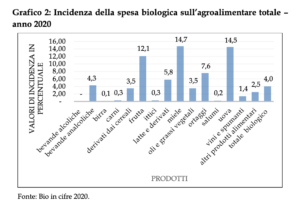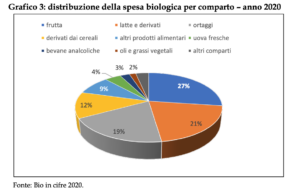Because the Court of Auditors beats the Ministry of Agriculture on organic products

What emerges from the report of the Court of Auditors on state funding for research in organic farming
A real gold mine. This is the sector of organic agriculture which in just over a decade has seen its turnover triple . The turnover, acknowledges the Court of Auditors , between internal consumption and exports, went from 2 to 6 billion euros in the period 2008-2020 . The cultivated area has expanded from 1.3 million hectares in 2014 to over 2 million in 2020 .
However, the Court of Auditors highlighted, in the FUNDING FOR RESEARCH IN ORGANIC AGRICULTURE report that the sector was unable to use the resources made available by the Organic Research Fund , a piggy bank set up to support the National Strategic Plan.
THE EXPENDITURE FOR ORGANIC IN ITALY
The overall incidence of organic sales on Italian agri-food expenditure in 2020 was 4 percent.

Furthermore, in 2020, organic food expenditure is distributed in the following sectors:
- fruit
- derived from non-alcoholic cereals
- milk and derivatives
- vegetables
- fresh eggs
- other food products vegetable oils and fats
- other sectors

ORGANIC FARMING: THE COURT OF AUDITORS 'ANALYSIS
The Court analyzed the financial management of the Fund available to organic farming . In particular, chapter 7742 of the Mipaaf forecast. “Management has highlighted critical profiles, with particular reference to the significant formation of residues, which, moreover, is largely attributable to the specific characteristics of the procedure for allocating resources”, reads the report.
THE NUMBERS OF NON-USE OF FUNDS
The administration, while being able to count on appropriations, did not commit them in the exercise of competence. Basically there are funds left unused which were, therefore, reallocated the following year. Specifically, “there is a significant presence of savings, given both by the non-commitment of sums allocated to the accruals account for an amount of 13,801,531 euros, and also by the elimination of residuals, for 11,839,319 euros, for a total of 25,640. 850 euros in the period under review ".
THE BUROCRATIC DELAYS
The Court also identified problems from an organizational point of view, cumbersome administrative procedures, and suggested trying to speed up the procedures "starting from the evaluation phase of the project proposals up to ascertaining the adequacy of the costs incurred" and "the settlement of the contributions granted, also to limit the formation of residues and achieve a more effective disposal of the same ".
THE REASONS FOR BUROCRATIC LENGTHS (WHICH DO NOT CONVINCE THE COURT)
The administration of the Fund, faced with the findings regarding the " low incidence of the residual account paid on the expendable mass ", as defined by the Court of Accounts, replied that part of the delays are due to the time of the administrative procedure because for settlement of the balance and verification of expenses incurred is necessary:
- “Wait for the conclusion of the project (duration 24-36 months);
- to appoint by a directorial decree a commission in charge of verifying the results of the project from a technical point of view and from an administrative and accounting point of view the regularity of the expenses incurred;
- the aforementioned commission must meet in one or more sessions to verify the results of the project and consequently propose the settlement or reduction of expenses;
- draw up a report aimed at requesting the re-entry of the amounts due or the cancellation of part of the same;
- finally, liquidate the balance ".
THE COURT'S SUGGESTIONS FOR LIMINATING PROCEDURES
However, according to the Court, the bureaucratic delays are not enough to justify the immobility of the available resources. And, moreover, it suggests a series of measures that the administration should have adopted to streamline the processes such as: "the establishment of a permanent evaluation commission", or the introduction of "more streamlined methods of dialogue with the proposing subjects ". "The issue of bureaucratic delays is long-standing and central, but the wrong way to solve it is a total deregulation – said the Minister of Agriculture Stefano Patuanelli to Il Sole 24 Ore – there are tools and technologies that allow us to activate control mechanisms in a simple, quick and automatic way, without having to switch to paper ".
IN 2021 ONLY 4% OF THE FUNDS AVAILABLE FOR ORGANIC AGRICULTURE
Finally, the Court reiterates again that the most critical point concerns "the minimal values of the paid in relation to the spendable amount". The figure is actually very low, “for the whole of 2021, the average of the same is equal to 6.57 per cent in the last six years”. Worse has gone in the last two years: “ 2020 and 2021 record a paid value equal, respectively, to only 8 and 4 percent ”. In conclusion, the Court does not find plausible justifications explaining "the modesty of the percentage" of the amounts disbursed and the immobilization of the funds , also in light of the fact that the administration can "grant advances of up to 60 percent of the total amount to the proponents of the project, and advance payments of up to 90 per cent depending on the state of progress ".
This is a machine translation from Italian language of a post published on Start Magazine at the URL https://www.startmag.it/economia/perche-la-corte-dei-conti-bacchetta-il-ministero-dellagricoltura-sul-bio/ on Mon, 06 Jun 2022 05:10:56 +0000.
